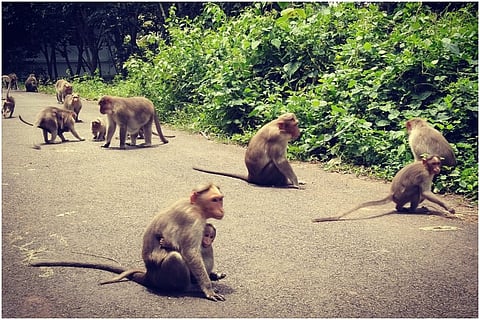

Sayipp was different from the rest. After all, his name was the colloquial version of Sahib, the term used to refer to British officials in the colonial era. He was the leader of his troop, had a different colour and was bossy; plainly, he wielded power, the residents of Sasthamkotta in Kerala’s Kollam district distinctly recall. However, they are sad that Sayyip’s children now wander around the market and residential areas causing pandemonium. Most unfortunate of all, one of his sons now heads a gang of ruffians at the market.
Sayipp was a monkey, lovingly named so by locals, who died two years ago. Monkeys play a prominent role in the life and history of the Sasthamkotta gram panchayat in Kollam.
The village now has two gangs of monkeys: temple monkeys, who reside in the famous Sasthamkotta Sree Dharma Sastha temple and market monkeys, who roam around in the market nearby. They have been residents of Sasthamkotta for many decades.
Perhaps there may only be one group of monkeys in the whole world with a fixed bank deposit. Yes, you heard that right. Descendents of Sayyip have a fixed deposit amount of Rs 10 lakh in the bank so they never have to struggle for food.
“It is believed that Lord Rama had visited Sasthamkotta while returning after the war with Ravana. He took a bath in the lake here, as per the legend. He also assigned a few monkeys from the nearby forests to take care of the Lord Ayyappan (Dharma Sastha) in the temple. So it is believed that temple monkeys are the descendents of those guardians of Lord Ayyappa,” Dileep Kumar, Sasthamkotta Panchayat member, says.
So, for this reason, temple monkeys are considered holy and they are taken good care of by the temple authorities and locals.
“Rs 5 lakh was sponsored by a person in the locality who works abroad. Another Rs 5 lakh was given by the temple committee. They are fed with fruits in the morning. In the afternoon, they will have rice, which is the offering at the temple. There are more than 60 temple monkeys and they never go out of the temple premises,” Dileep said.
The temple monkeys get a scrumptious sadhya (feast) on Onam and Vishu festival days. They are served in plantain leaves with different varieties of dishes, as per tradition.
Even as they lead a royal life in the temple, they have a rival group outside — a group that doesn't believe in living within boundaries or sacrificing freedom for comforts like timely food. They are called ‘market monkeys’ by the locals. There are about 100 such monkeys in the area.
Market monkeys, by contrast, are the rebels. They are the offspring of the monkeys who left the group of temple monkeys. Either they lost the group unknowingly and did not return, or parted ways after a fight, according to locals. They later turned into a gang giving headaches to locals. The gang leader is called Kochu Sayyip (Little Sayyip) as he is the son of Sayyip, according to local legend.
“They are the biggest menace in this area. They eat up everything. Plants, food in the kitchen, agricultural products and whatever else possible. Apart from eating up everything, they also destroy things. They break the water tanks, take away clothes, shoes and other things from houses,” Dileep laments. This gang is also accused of attacking children who walk through their bastions.
Dileep had even visited Forest Minister K Raju, requesting him to find a solution. “The issues with these monkeys had started decades ago. People here are tired of complaining,” he adds.
Since the temple monkeys get enough food, they are calm. But the market monkeys are in hunger. Lockdown days were the hardest for them. Since there were no shops or restaurants open, they doubled their mischief. Residents say they went inside many homes and ate everything.
In 1999, the residents protested against the ‘monkey menace’ and approached the court for a solution. Finally, the district court ordered the volunteers of the NGO People For Animals to shift 102 monkeys to the Kaanayar Forest area in Achankovil with the help of an expert team ‘Vatavaran’ from Delhi.
“After that their numbers again multiplied. If there is no solution, we will have to approach the court again,” Dileep rues.